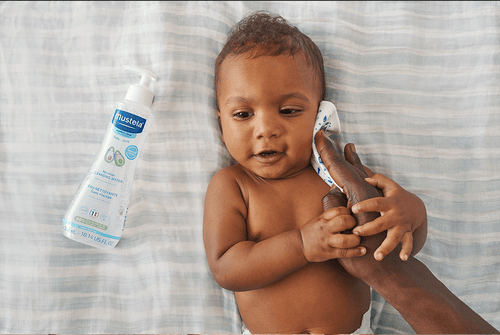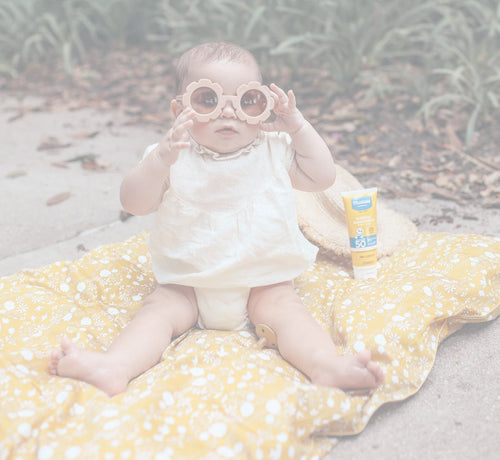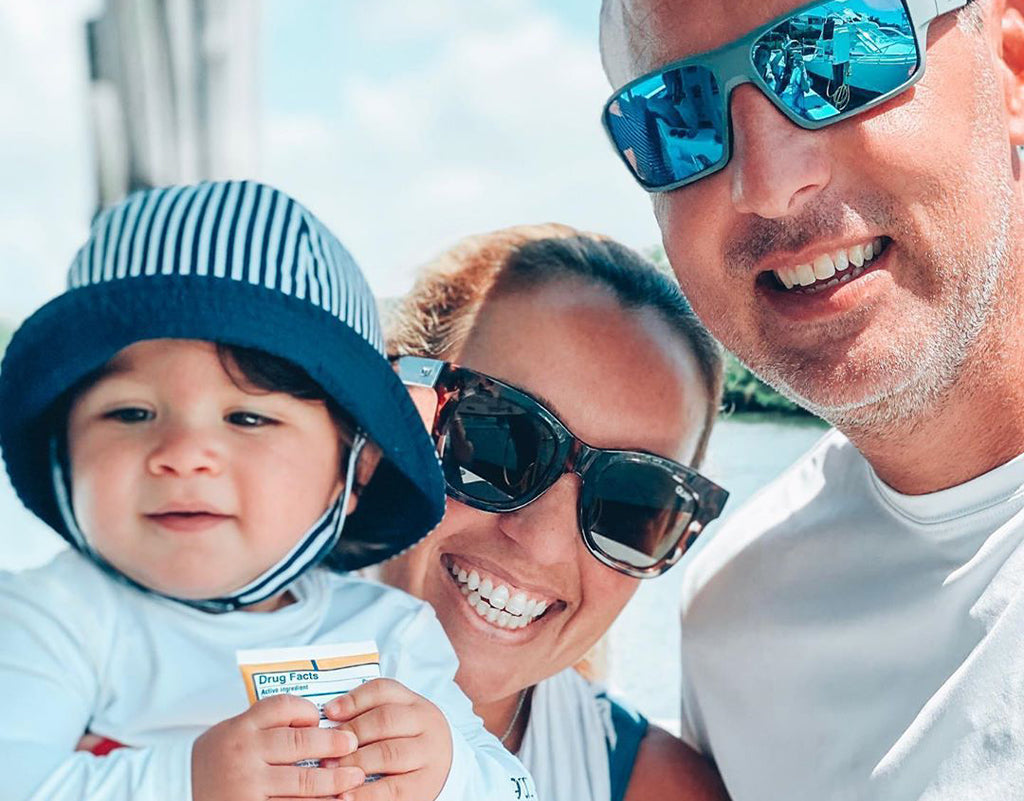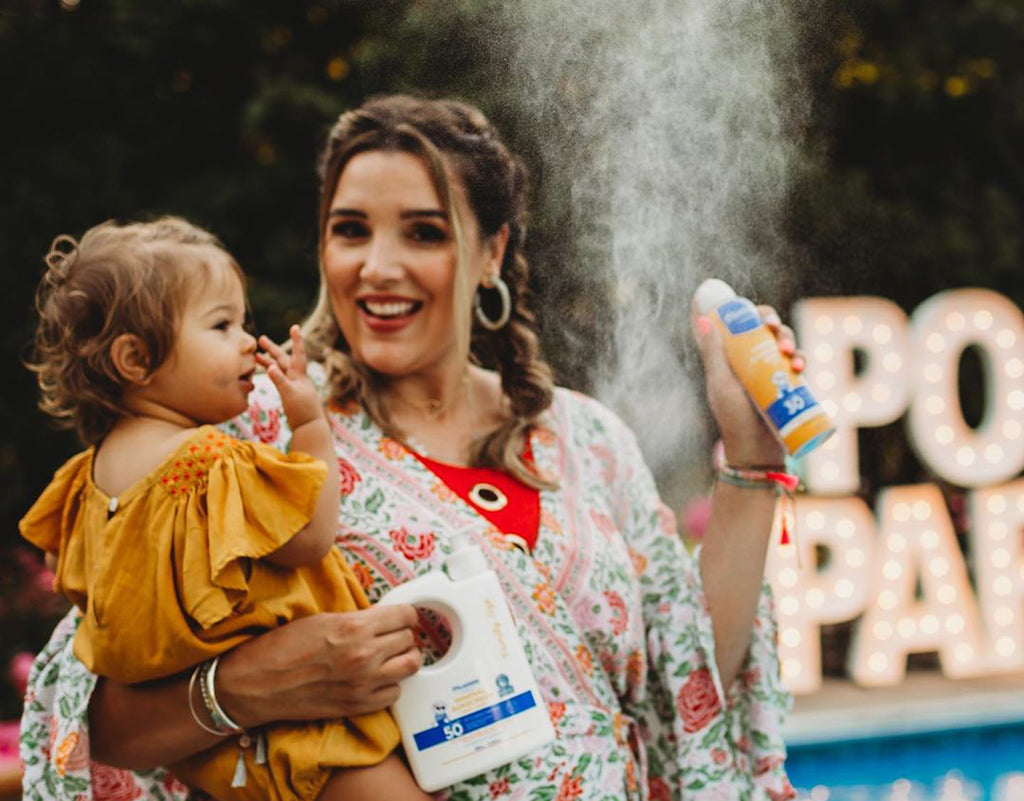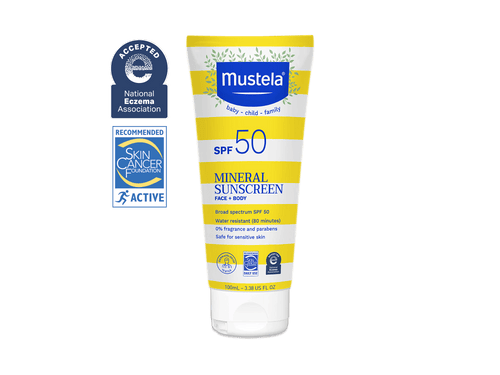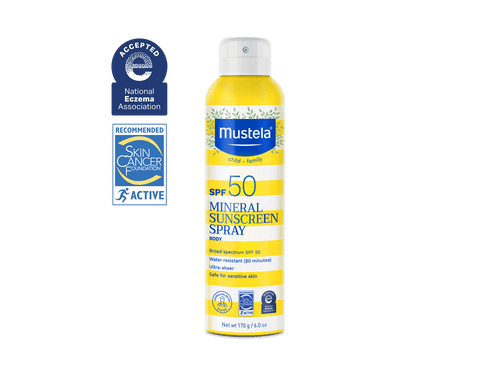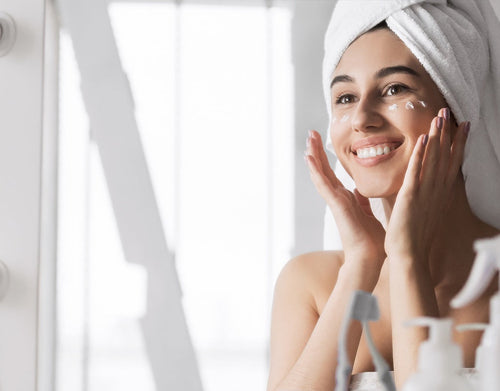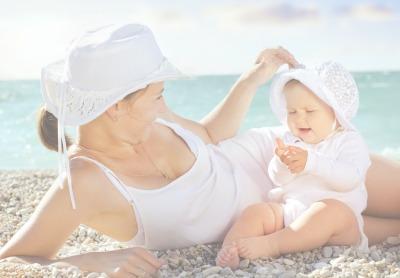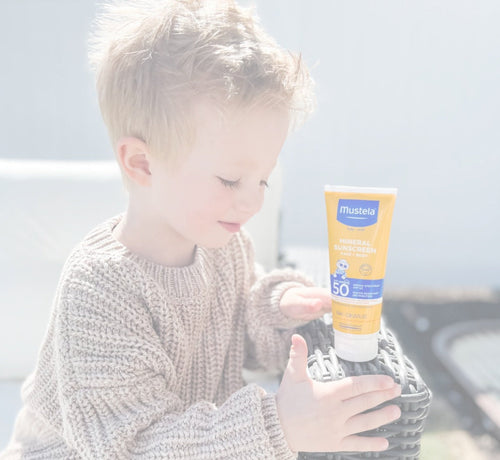You know the sun’s rays can be harmful, but you aren’t sure your little one is ready for sunscreen. When can babies wear sunscreen? And if they’re not old enough, how can you keep their skin safe when you’re outside?
The Mustela team is here to help you answer these questions and more. We’ll look at sunscreen age recommendations and safe sun practices for newborns and older babies. Then, we’ll teach you how to use sunscreen like a pro.
Table Of Contents
- When Can Babies Wear Sunscreen?
- Safe Sun Practices For Babies
- How To Apply Sunscreen On Babies
- How Much Sunscreen Should Babies Wear?
- What To Look For In Sunscreen For Babies
- General Sun Safety Tips For Babies
When Can Babies Wear Sunscreen?
Newborns have delicate skin. Because of this, most experts recommend waiting until your baby is six months old before regularly applying sunscreen.
The American Academy of Pediatrics recommends keeping young babies out of direct sunlight as much as possible. They also encourage using protective clothing and sticking to shady areas outside.
However, the group acknowledges that sometimes, sun exposure is unavoidable. When this happens, it suggests using sunscreen only on exposed areas. For example, if your new baby is in long sleeves, pants, and a hat, consider putting sunscreen on their face and hands.
Then, when they’re six months old, you can use sunscreen more liberally.
Why Shouldn’t Newborns Wear Sunscreen?
The ingredients found in some sunscreen products (such as perfume) can irritate sensitive baby skin and cause a rash or another type of reaction.
In addition, newborns don’t have all their melanin, the skin’s natural pigment that offers some protection from the sun’s rays. Until this develops, babies are especially sensitive to ultraviolet rays. They can get sunburned much quicker than an older baby or an adult.
That’s why the best practice is to keep them out of the sun as much as possible. Sunscreen may give you a false sense of safety and cause them to get too much exposure or irritate their skin.
Thus, most experts agree newborns shouldn’t wear sunscreen unless sun exposure is unavoidable.
Safe Sun Practices For Babies
Now that you know the standard recommendations for when babies can wear sunscreen, let’s look at some practical, safe sun practices you can adopt for little ones of all ages.
0-6 Months

As already established, sun safety for newborns is all about avoidance. This means keeping your baby out of direct sunlight. These tips can help.
Choose Sun-Protective Clothing
When you go outside, dress your baby in lightweight clothing and add a wide-brimmed hat to help keep their face out of the sun.
Select long-sleeved shirts and pants instead of a sundress or shorts and a t-shirt. It might not seem like much, but the extra fabric can help keep the sun’s rays off your baby’s skin.
Sunglasses are also a good idea if your baby tolerates them. Some babies hate having things on their faces like that and will immediately try to yank the glasses off. However, if you start this practice when your baby is a newborn, they’ll be more used to the feel of the sunglasses.
If you’re selecting swimwear for your baby, skip the cute, tiny two-piece and get the longer board shorts and a rash guard instead. Rash guards are shirts made from swimsuit material, so they’re comfortable to wear in the water. Many brands have built-in SPF protection.
Stay In The Shade
Shade is your friend when you’re outside with a newborn. Look for shady areas and stay in them as much as possible. This is especially important between 10 a.m. and 4 p.m. when UV rays are the strongest.
Here are some practical steps you can take:
- Consider using a stroller or car seat with a canopy to provide additional shade.
- Use a large umbrella at the beach to create shade.
- Bring a pop-up tent or sun shelter to provide shade at the park or during other outdoor activities.
- Create shade by clipping a muslin-swaddling blanket to a nearby table or bench.
- Sit under a tree, building overhang, or covered porch if available.
- Use a window shield on your car next to your baby’s seat.
Minimize Sunscreen Use
While sunscreen isn’t usually recommended for young babies, it’s safer than the alternative of a sunburn. So, if direct sunlight is unavoidable, apply a small amount of baby-friendly sunscreen to exposed areas of the skin.
If your baby wears pants, a long-sleeved shirt, and socks, very little skin will stick out. The only things showing will be their face, the top of their head, their neck, and their hands. Apply sunscreen only to these areas.
Keep an eye on the time; if you’re out longer than two hours, you must reapply sunscreen. And when you go back inside, gently wash it off to remove any residue.
6 Months And Up
Once your baby turns six months old, their skin has had a chance to adjust to the world outside the womb. It’s better developed and is ready for more frequent sunscreen use.
Before heading outside, take time to apply baby-friendly sunscreen. We’ll cover what to look for when you’re picking a product in a bit.
When putting sunscreen on your little one, pay special attention to often-forgotten areas, like the nose, back of the neck, and top of the head. Go slowly so you don’t get sunscreen into your baby’s eyes or mouth.
After applying, keep an eye on the clock. Sunscreen eventually wears off, and you must reapply it every two hours to keep your child safe. A timer on your phone is a simple way to stay on schedule.
Also, remember that even though your child is wearing sunscreen, it’s still best to keep them out of direct sunlight as much as possible. Select clothing options that offer maximum protection and stay in the shade when you can. This way, you can avoid painful sunburns.
How To Apply Sunscreen On Babies
Sunscreen is an important part of sun safety for older babies and everyone else. But applying sunscreen on a squirming baby isn’t for the faint of heart.
Here are some tips to help make the process easier.
Read The Label
Sunscreen only works when it’s applied correctly. And since every brand of sunscreen is slightly different, it’s essential to read the label before use. That way, you can ensure proper protection from the sun.
While looking at the label, check the expiration date as well. Sunscreen, like other skincare products, does expire. If it’s too old, it may not work as well.
Do A Spot Test
All babies have delicate skin, but some have extremely sensitive skin. If you’ve never used a particular sunscreen on your little one, do a spot test the day before you plan to be in the sun.
Simply apply a tiny amount of sunscreen on the inside of their wrist and watch for reactions. Redness or a rash means your baby is sensitive to something in the formula, and you’ll want to choose a gentler sunscreen, like SPF 50 Mineral Sunscreen Spray and Stick from Mustela.
Always Apply On Dry Skin
If you try to put sunscreen on damp skin, it won’t absorb properly. So if your little one is wet or sweaty, dry them off before rubbing on more.
Decide Which Application Method Is Best
You can get sunscreen in a few different forms. It comes as a spray, stick, and lotion.
Each type has pros and cons, so consider getting an SPF 50 Mineral Sunscreen Set from Mustela. It has one of each, so you can try them all.
Then, you can use the spray to quickly apply sunscreen over most of your baby’s body. However, since you can’t spray sunscreen directly on their face, you can switch to the lotion for that area.
Remember The Forgotten Bits
When applying sunscreen, it’s easy to forget a few spots. Remember to put it on your baby’s:
- Ears
- Nose
- Back of the neck
- Back of the legs
- Tops of the feet (if not wearing socks or closed shoes)
- Scalp (or part-line if they have a lot of hair)
Paying attention to all of these places will help prevent sunburn from head to toe.
Apply On Their Hands Last
In the time it takes you to blink, your baby can shove their hand in their mouth. They could easily rub some in their eyes, too, while you’re busy trying to sunscreen the rest of them.
To avoid this, put sunscreen on their hands last. Then, gently hold onto them until the sunscreen has absorbed for a few minutes and is less likely to transfer from one place to another.
How Much Sunscreen Should Babies Wear?
Newborns should wear the least amount of sunscreen possible. When you need to apply it, use a small amount on the exposed areas of their body.
As they get older, it’s safer to apply sunscreen all over. At this point, plan on using about ½ an ounce to cover their entire body, plus a bit more for their face.
What To Look For In Sunscreen For Babies
Babies need a sunscreen that’s formulated for their sensitive skin. You’ll want to look for four key things when deciding which brand to buy.
Broad Spectrum Protection
The sun emits two types of harmful rays, UVA and UVB. UVB is the one that most often causes sunburn, but UVA rays also have devastating effects on the skin and can contribute to signs of aging. Look for a sunscreen that offers protection from both.
You should see "Broad Spectrum" or "UVA/UVB" on the label. If you don’t, it’s likely that your baby won’t be fully protected.
Mineral Sunscreen Instead Of Chemical
Speaking of protection: Sunscreen can be divided into two main categories, chemical and mineral. As the name suggests, chemical sunscreen uses ingredients that cause a chemical reaction, absorbing the UV rays and turning them into heat.
Mineral sunscreen works differently. It uses ingredients like zinc oxide to form a protective barrier on your skin. When UV rays hit this barrier, they’re reflected away.
Since babies have delicate skin, mineral sunscreen is the better option. The product sits on top of the skin instead of absorbing into it.
The Right SPF
SPF stands for Sun Protection Factor. It indicates how much of the sun’s UVB rays the product will absorb or reflect. However, SPF 30 doesn’t block twice as much as SPF 15. Instead, scientists devised a special formula to calculate the SPF value.
According to the formula, an SPF of 30 blocks about 97% of UVB rays. When you increase to SPF 50, it blocks 98%. Keep in mind that no sunscreen protects against 100% of the sun’s rays.
For babies, use a minimum of SPF 30. If you’ll be out for long periods, opt for SPF 50 for even more protection.
Stand-Alone Product
Some sunscreens also include bug repellent. While this might seem practical if you’re worried about bug bites, avoiding this combination product is best for babies.
You need to reapply the sunscreen at least every two hours. Unfortunately, most bug repellents last much longer than that. If you keep putting the combined product on your little one, they’ll wind up with too much repellent.
Instead, choose stand-alone products. It’s OK to use sunscreen and then apply a baby-safe bug repellent. Then, you can follow the reapplication instructions for each one individually.
General Sun Safety Tips For Babies
Sunscreen is one aspect of sun safety, but it’s not the only part of the equation. Here are some other safety tips to consider.
Offer Fluids
Babies can quickly become dehydrated in the hot weather. When your baby is out, offer them plenty of age-appropriate fluids.
For newborns, this means breastmilk or formula. Once your little one is eating solids, you can offer water as an additional source of hydration.
Watch For Signs Of Heat Exhaustion
Heat exhaustion is a major concern for anyone on a hot day, but babies are especially susceptible. Keep your eyes peeled for any of the following signs in your little one:
- Being extremely fuss
- Crying excessively
- Developing a rapid heart rate
- Having paler skin than normal (check their palms, nails, and tongue)
- Throwing up
If your baby is overheating, immediately take them to a cooler location and give them age-appropriate liquids.
You should also contact your doctor for their guidance. Heat exhaustion can quickly lead to heat stroke, which is very dangerous.
Use Sunscreen All Year
While you may only think about sun protection in the summer, the sun’s rays shine down on us all year round. In the winter, they can reflect off the snow and cause severe sunburn.
Make sun safety part of your skincare routine to protect your little one. If they’re over six months old, sunscreen should be used anytime you go outside.
Refresh Your Sunburn First Aid Skills
The goal is to use the tips above to prevent sunburn. But sometimes, despite our best efforts, sunburns happen. If your baby gets one, it’s important to know what to do.
1) Recognize The Signs Of A Sunburn
While redness can alert you that your baby has a sunburn, that’s not the only symptom you may notice. Their skin may also feel warm to the touch and be painful or itchy.
These are all signs of a mild sunburn. You should be able to care for this type at home. However, some other symptoms indicate that the sunburn is more serious and will require medical attention. We’ll cover those below.
2) Understand Home Care For Mild Sunburns
For home care, utilize the following tips:
- Get out of the sun as soon as you see signs of a sunburn.
- Bath your baby in lukewarm water to remove the sunscreen and start cooling their skin.
- Use a moisturizing product with aloe vera, such as our Organic Hydrating Cream with Olive Oil and Aloe.
- Ensure they drink plenty of liquids for the next couple of days.
- Talk to your doctor about giving your child pain-relieving medication such as ibuprofen or acetaminophen as needed.
- If you go back outside before the skin heals, ensure the sunburnt area is completely covered so it doesn’t worsen.
3) Know When To Call The Doctor
Not all sunburns are mild. If you notice any of these symptoms, it means your little one has a severe sunburn, and you should consult your doctor:
- Blisters
- Swelling
- Sunburn covers a large portion of their body
- Chills or a fever
- Decreased urine output
- Lethargy
- Muscle weakness
Of course, if you’re concerned about your child’s health or condition for any reason, contact your healthcare provider.
Set A Good Example
Your baby is watching you and wants to be just like you. So, set a good example by caring for your own skin!
Let them see you put on sunscreen (Mustela’s sun care products work for the whole family) and practice other sun-safe habits.
Talk to your child about why you’re making certain choices outside. Let them understand your thought process with a narrative like this:
The sun is beaming down today, and I want to keep our skin safe so we don’t get a painful sunburn. I’ll look for a shady spot to set up our blanket. Do you see how the ground is darker over there under the big tree? That’s shade! That’s where we’ll go.
While your baby won’t get much out of this conversation at first, they’ll eventually start to understand what you’re doing and why. That can help them make good decisions when they’re older and away from you.
Plus, caring for your skin helps protect you from skin cancer. And you’re important too!
Gradually Increase Exposure
Being out in the sun is a brand-new experience for babies. To help their bodies adjust, you’ll want to introduce them to sunlight gradually.
Start with short periods of time outdoors, avoiding peak hours. A couple of minutes is plenty for a newborn. As your baby grows and their skin becomes more resilient, gradually increase your time spent outside.
However, no matter how used to the sun your baby gets, sunburn is still a risk. So always use sunscreen and the other tips mentioned earlier.
Keeping Your Baby Safe In The Sun

So when can babies wear sunscreen? It’s best to keep them out of the sun until they’re six months old. At that point, you can use a baby-friendly sunscreen, like the Suncare Products from Mustela.
To protect your little one’s skin, avoid direct sunlight whenever possible and use lightweight, long sleeve clothes, wide-brimmed hats, and the canopy on their car seat or stroller to accomplish this goal.
And if you know that your baby will be exposed to the sun, applying a baby-friendly sunscreen to small parts of their body is OK. That’s where our SPF 50 Mineral Sunscreen Lotion comes in. It’s perfect for the whole family.
Slather up and enjoy the sunshine together!

